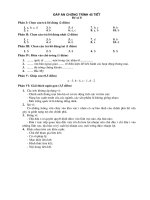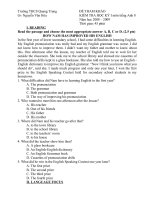PASSAGE 8
Bạn đang xem bản rút gọn của tài liệu. Xem và tải ngay bản đầy đủ của tài liệu tại đây (31.39 KB, 2 trang )
PASSAGE 8
Traditionally in America, helping the poor was a matter for private charities or local governments.
Arriving immigrants depended mainly on predecessors from their homeland to help them start a new life.
In the late 19th and early 20th centuries, several European nations instituted public-welfare programs.
But such a movement was slow to take hold in the United States because the rapid pace of
industrialization and the ready availability of farmland seemed to confirm the belief that anyone who was
willing to work could find a joB.
Most of the programs started during the Depression era were temporary relief measures, but one of the
programs Social Security - has become an American institution. Paid for by deductions from the
paychecks of working people, Social Security ensures that retired persons receive a modest monthly
income and also provides unemployment insurance, disability insurance, and other assistance to those
who need it. Social Security payments to retired persons can start at age 62, but many wait until age 65,
when the payments are slightly higher. Recently, there has been concern that the Social Security fund may
not have enough money to fulfill its obligations in the 21st century, when the population of elderly
Americans is expected to increase dramatically. Policy makers have proposed various ways to make up
the anticipated deficit, but a long-term solution is still being debated.
In the years since Roosevelt, other American presidents have established assistance programs. These
include Medicaid and Medicare; food stamps, certificates that people can use to purchase food; and public
housing which is built at federal expense and made available to persons on low incomes.
Needy Americans can also turn to sources other than the government for help. A broad spectrum of
private charities and voluntary organizations is available. Volunteerism is on the rise in the United States,
especially among retired persons. It is estimated that almost 50 percent of Americans over age 18 do
volunteer work, and nearly 75 percent of U.S. households contribute money to charity.
Question 1. New immigrants to the U.S. could seek help from ______.
A. the people who came earlier
B. the US government agencies
C. only charity organizations
D. volunteer organizations
Question 2. It took welfare programs a long time to gain a foothold in the U.S. due to the fast growth
of______.
A. industrialization
B. modernization
C. urbanization
D. Population
Question 3. The word “instituted” in the first paragraph mostly means ______.
A. “executed”
B. “studied”
C. “introduced”
D. “enforced”
Question 4. The Social Security program has become possible thanks to ______.
A. deductions from wages
B. people’s willingness to work
C. donations from companies
D. enforcement laws
Question 5. Most of the public assistance programs ______ after the severe economic crisis.
A. were introduced into institutions
B. did not become institutionalized
C. functioned fruitfully in institutions
D. did not work in institutions
Question 6. That Social Security payments will be a burden comes from the concern that ______.
A. elderly people ask for more money
B. the program discourages working people
C. the number of elderly people is growing
D. younger people do not want to work.
Question 7. Persons on low incomes can access public housing through ______.
Page 1
A. low rents
B. state spending
C. donations
D. federal expenditure
Question 8. Americans on low incomes can seek help from ______.
A. federal government
B. government agencies
C. state governments
D. non-government agencies
Question 9. Public assistance has become more and more popular due to the ______.
A. young people’s voluntarism only
B. volunteer organizations
C. people’s growing commitment to charity
D. innovations in the tax system
Question 10. The passage mainly discusses ______.
A. public assistance in America
B. immigration into America
C. funding agencies in America
D. ways of fund-raising in America
ĐÁP ÁN
1-A
2-A
3-C
4-A
5-B
6-C
7-D
8-D
9-C
10-A
Page 2









